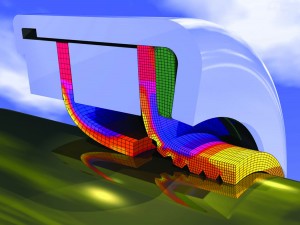One of the first hurdles to overcome in developing an accurate finite element representation of a real world problem, including rotary shaft seals, is developing the model of the components whose behavior and interaction you want to investigate.
Seal Geometry: 2D or 3D?
Even standard laptops are powerful enough now to handle FEA analysis of multiple 3D components, though it make take a while. However, not all scenarios have to be modeled in 3D to capture the basic behavior of the system. There are times when 2D models can work extremely well. The key thing to remember when simplifying the model is that just because the geometry of a part may be symmetric (including vertical, horizontal, and axisymmetry) the loads may not be.
For example, if you are trying to model a seal when the frictional force varies along the face of the seal as it contacts the shaft, then a 2D model will not accurately capture that behavior. However, using ¼ of a 3D model or even ½ of a 3D model could accurately represent the stress and strain effects in the area of interest.
In some cases, it is possible to take a part that initially looks as if it needs to be modeled in 3D and reduce it to 2D by adjusting its parameters. This was done effectively by Olof Calonius and Matti Pietola when modeling a cantilevered spring for a spring-energized seal.
Element Type
There are many different types of elements available to the modern analyst, dependent in part on the type of software being used. Element type begins with 2D or 3D, which is based on how you decide to model the system. Then there are other decisions, such as:
- whether isoparametric or hierarchical elements should be used
- whether curved surfaces should be implemented or merely approximated by straight line segments
- and, whether you are using explicit or implicit elements.
Another key factor in the selection of element type depends on whether you are modeling linear behavior or non-linear behavior. Non-linear elements are, by their very nature, going to be more complex but may be necessary for an accurate model. If you are including multiple parts in your model (e.g., seal lip, energizing spring, etc.), it is also important to make sure that the elements used for each part are compatible with each other.
Selecting Boundary Conditions
Without sufficient boundary conditions, a finite element model will not be able to reach a solution.
Some boundary conditions are applied in order to correctly take advantage of symmetry, while others represent the real-world conditions in which the seal is being implemented. Commonly used boundary conditions include displacement-based conditions, where a surface/edge is not allowed to move or can only move a certain amount; and, rigid boundary conditions, where an edge/surface is interacting with another edge/surface that is much, much more stiff. These can be applied along one or more dimensions as well as rotationally. For thermal analysis, boundary conditions include insulated surfaces, constant temperature surfaces, etc. Again, some boundary conditions will need to be applied to correctly account for symmetry
Selecting Loads
The main loads under consideration when it comes to modeling rotary shaft seals are pressure and friction. A correct coefficient of friction must be chosen, and how that friction is applied depends on both the software used and the type of analysis being performed. Loads can be made to vary with position (linearly or radially) or time (for transient analysis). Finally, keep in mind that accurate values must be used for the model if useful results are expected.
Conclusion
A finite element solution is only going to be as good as the model behind it. The geometry must be modeled correctly, and boundary conditions applied accurately if you are taking advantage of symmetry. Boundary conditions must be selected to correctly represent how the seal is going to behave and loads must reflect real world conditions as much as possible. The more closely the model represents real-world conditions, the more useful it will be.
{{cta(‘9c7fab19-3e70-4606-87dd-468123217802′,’justifycenter’)}}

